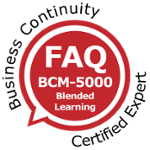 Reporting and Presenting Risk Analysis Findings to Executive Management
Reporting and Presenting Risk Analysis Findings to Executive Management
![]() As part of the BCM-5000 Module 3 Pre-reading List, this section prepares you to compile and present the Risk Analysis and Review (RAR) Report to Executive Management—a critical step in ensuring your organisation’s risk landscape is well understood and proactively managed.
As part of the BCM-5000 Module 3 Pre-reading List, this section prepares you to compile and present the Risk Analysis and Review (RAR) Report to Executive Management—a critical step in ensuring your organisation’s risk landscape is well understood and proactively managed.
Upon completing BCM-300 or BCM-5000 Module 2, you will have gained the competencies of a Business Unit (BU) BCM Coordinator, including hands-on experience with the RAR questionnaire.
This process enables you to identify potential threats, assess their impact, and understand the challenges of risk assessment at the business-unit level.
In Modules 3 and 4, your role expands to that of an Organisation BCM Coordinator. You must consolidate, analyse, and effectively present the RAR findings in a structured report for Executive Management’s review and approval.
This content is adapted from the BCM Planning Series: Analysing & Reviewing the Risks for Business Continuity Planning. It provides a structured approach to risk analysis and presents best practices.

Report on RAR Findings

 The outcome of the Risk Analysis and Review (RAR) phase should be presented systematically and analytically.
The outcome of the Risk Analysis and Review (RAR) phase should be presented systematically and analytically.
It is imperative that Executive Management understands the risks and allocates resources to reduce and correct potential losses.
- Serve as the vehicle for presenting the findings of the RAR process and recommendations
- Provide the organisation with the information needed to make informed decisions about the threat issues.
These are some actions that must be taken when handling the report. The RAR report and related documentation should:
- Be forwarded to the Executive Management for prompt review, approval and action
- Include only the summary information
- Contain working papers and detailed analyses that support the findings and recommendations outlined in the report for reference purposes and as a resource for future RAR exercises.
- Be considered sensitive information and be protected accordingly
- Not intended for general distribution
The design layout of a RAR report as per instructions from the BCM Team
Report Preparation & Distribution
The initial steps in preparing the RAR report are:
 Prepare a draft report containing initial findings and issues
Prepare a draft report containing initial findings and issues- Issue draft report to participating BU BCM Coordinators and BU Heads for their feedback
- Schedule a meeting and/or workshop to discuss the initial findings
Circulation of Draft Report
One success factor in delivering a good RA report is to share it with BU Heads and BU BCM Coordinators. It is essential that the BU Heads and BU BCM Coordinators:
- Be allowed to review the materials during the preparation of the report
- Confirm that the content is accurate
- Review the organisational-wide information and recommendations
- See how each piece of the organisation is interdependent
- Allow them to become familiar with the information
- Feel ownership
- Provide input on how to present this report to Executive Management best
 This report should also be available to the BCM team members and the BCM Steering Committee. This step is essential to the Organisation BCM Coordinator and the organisation's long-term success.
This report should also be available to the BCM team members and the BCM Steering Committee. This step is essential to the Organisation BCM Coordinator and the organisation's long-term success.
It is crucial to distribute the RAR report because the action items, controls, and many of its elements are the responsibility of multiple areas of the organisation. Those responsible should be kept informed early in the report's writing. As an Organisation BCM Coordinator, you do not want to assume anything. Confirm with the team the most effective approach to ensure all participants and their BU Heads have reviewed the information.
As an Organisation BCM Coordinator, you do not want to assume anything. Confirm with the team the most effective approach to ensure all participants and their BU Heads have reviewed the information.
This may be as simple as a follow-up meeting to discuss feedback, suggestions, and edits or as complex as conducting a facilitated session with the team.
The key deliverables are sign-off and consensus on the RAR findings and the subsequent report, which will be submitted to the decision-makers.
Report Design
The RAR report should be designed to answer the following:
- What is the mission?
- What are the organisation’s objectives?
- What are the deliverables?
- What are the RAR planning assumptions?
 What is the organisation protecting?
What is the organisation protecting?- What is the outage Risk Level?
- How do we establish support for implementing the RAR recommendations?
In the BIA report documentation, it is essential to note that granular information is not required in the executive summary; it should be included in the detailed text or appendices.
One of the key outcomes of the RAR report is identifying the organisation’s assets and areas of concern. The RAR report should also address the following.
Risk Consequence of the Threat
The consequence of a risk or a threat is that the organisation’s assets may be compromised or rendered unavailable.
Participation of Stakeholders
The findings report should summarise the configuration of the involvement of any team or key personnel in the research and data analysis effort.
It is essential to convey that these stakeholders participated in the entire process, including supporting the findings and final report.
Layout of Report
When writing the report, it must be presented in an “effective” manner.
Executive Overview
It is vital to have an executive summary or overview at the top of the report. This summary should convey the entire set of RAR activities in a few pages.
- Scope
- Objectives
- Approach taken
It is essential to summarise the data gathered, analysed, and reviewed by the Steering Committee, BU Heads, BU Coordinators, and BC Team.
Priority of Presentation
When preparing the report, the most significant Risk Level should be stated first, followed by the medium and lesser Risk Levels in order of magnitude. Quantitative and qualitative Risk Levels should be included to convey the difference and not confuse the target audience.
Two sections should also explain the quantitative and qualitative Risk Levels on a scale of most significant to least.
Conclusion
The conclusion should include the following:
- A realistic review and commentary, supported by executive management, recognises the positive capabilities, competencies, and efforts already in place.
- A cross-reference to similar projects discovered by the BCM Team through the RAR data gathering efforts. These should be limited to projects, activities, or efforts similar to, complementary to, or associated with the BCM program.
- Specific areas of concern that need attention are not current areas of strength for the organisation.
Recommendation
One key component of this section is to offer varied alternatives. During the RAR process, the Organisation BCM Coordinator should have obtained a variety of solutions to areas of concern, including the following:
- Provide alternatives
- Costing of alternatives
If specific costs for completed alternatives or solutions were encountered, they should be included or referenced in the RAr report.
Priority Action Items
If action items require the decision-makers’ approval, they should also be specifically identified.
Areas of Concern
If a BCm Team examines an area of concern discovered during the RAR, this should be included explicitly in the RA report.
 When briefing decision-makers, the Organisation's BCM Coordinator must confirm whether there is an exposure and whether it has been addressed or is being addressed.
When briefing decision-makers, the Organisation's BCM Coordinator must confirm whether there is an exposure and whether it has been addressed or is being addressed.Next Steps
This section needs to include the logical, agreed-upon action items approved by Executive Management.
- Acceptance of RAR findings
- Approval to conduct the BIA phase (if it is not completed)
- Approval to proceed with any identified action items or requested controls
Appendices
The appendices of the RAR report may include the following:
- List of participants who had participated in the RA exercise
- Consolidated recommendations list
- Detailed research notes (optional if the content is too complicated to be presented as a report)
 RAR Presentation
RAR Presentation
The presentation to Executive Management is the final and most crucial stage of the RAR process.
Follow-up After the Report
After the presentation is completed, it is not uncommon for specific enhancements or additional controls to need to be identified and their costs worked out. Executive Management has considered the comprehensive implications and elements associated with the BC planning effort.
More Information About Business Continuity Management Courses




![Register [BL-B-3]*](https://blog.bcm-institute.org/hs-fs/hubfs/hub_generated/resized/19a8306f-6b76-45ff-8585-95111f393aeb.png?width=200&height=56&name=19a8306f-6b76-45ff-8585-95111f393aeb.png)



![FAQ [BL-B-3]](https://blog.bcm-institute.org/hs-fs/hubfs/hub_generated/resized/9b7f5669-8ad6-450b-a98f-5f5d49ebfc8e.png?width=150&height=150&name=9b7f5669-8ad6-450b-a98f-5f5d49ebfc8e.png)
![Email to Sales Team [BCM Institute]](https://blog.bcm-institute.org/hs-fs/hubfs/hub_generated/resized/83ae9ad3-affc-416e-8f51-64218d6d98f2.png?width=100&height=100&name=83ae9ad3-affc-416e-8f51-64218d6d98f2.png)





